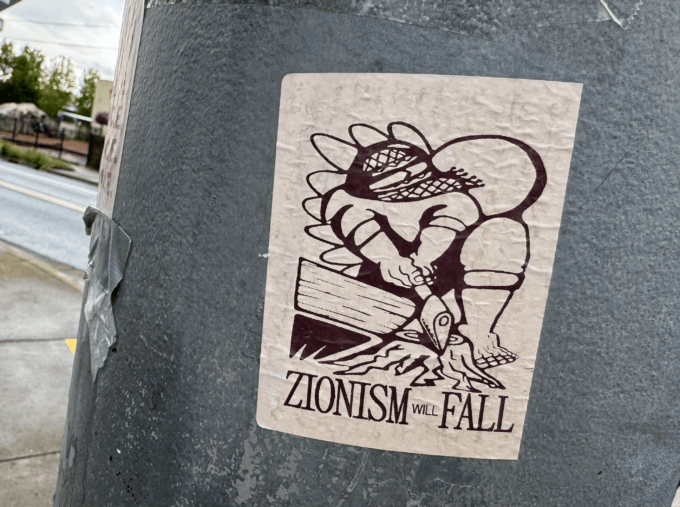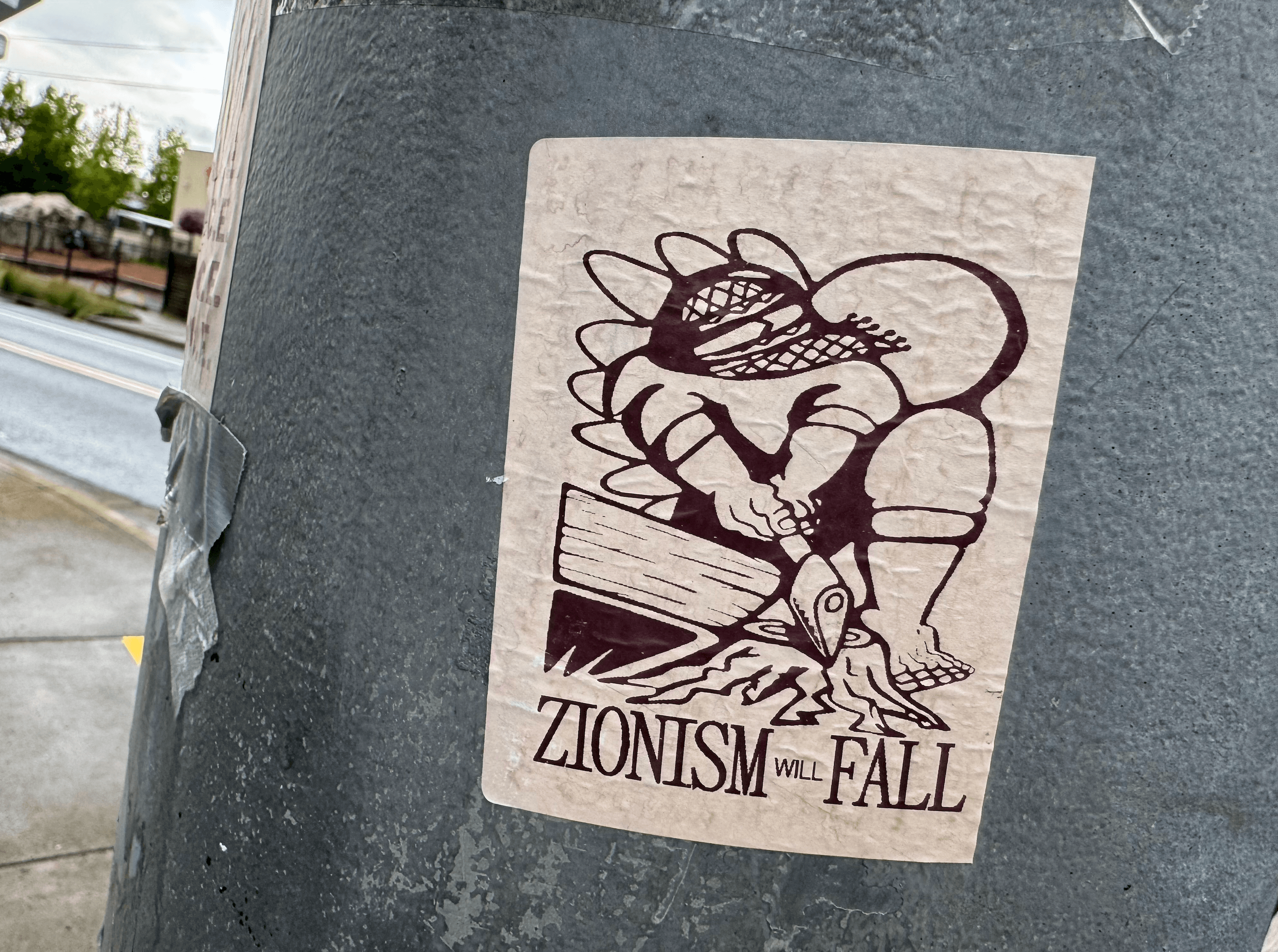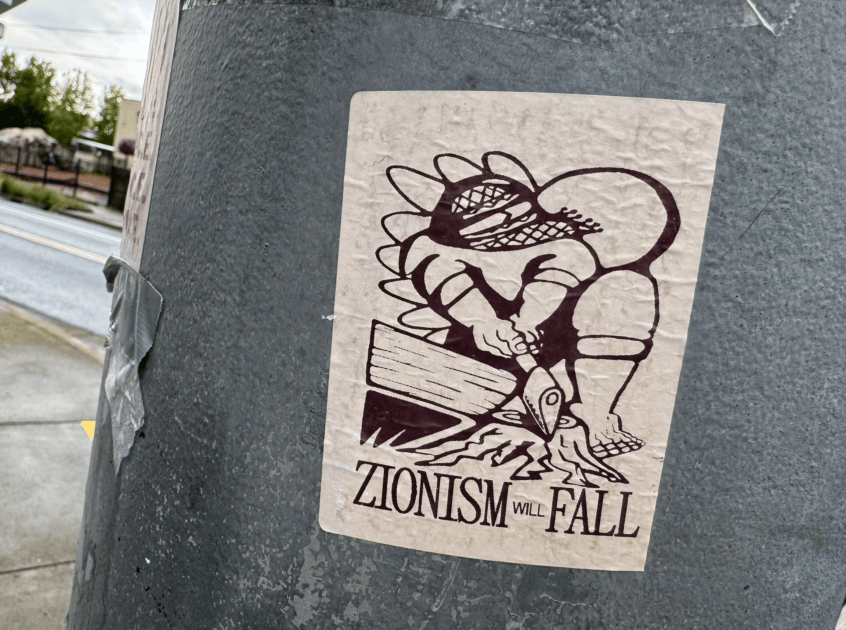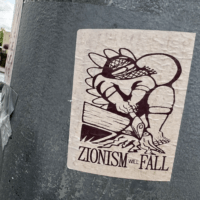






























































Photograph by Nathaniel St. Clair
On the same day that Israel’s genocidal army issued an evacuation order for Tehran for the first time, after having done so repeatedly in Gaza, Beirut, and Damascus, a statement came out of Iran by certain Iranian dissidents, including Nobel Peace Prize laureate Narges Mohammadi, demanding an “immediate halt to uranium enrichment by the Islamic Republic” and “the cessation of military hostilities.” Their language echoed that of European leaders who call on both sides to de-escalate. Such framing was, to say the least, misleading in a war waged by Israel against Iran.
It presents Israeli invasion as a “devastating war between the Islamic Republic and the Israeli regime,” thereby falling into a bothsidesism that equates the aggressor with the one being invaded. Of course, contrary to the Gaza war, where there exists only one side, namely Israeli genocide, in the case of Iran, there are two state parties involved in the war, as the Islamic Republic has also long cheered on catchy but empty rhetoric, calling for the annihilation of Israel.
Yet, any uninitiated observer would easily recognize the asymmetrical power dynamic between the two parties: one supported, funded, and armed by the United States and all Western powers, the other defending itself alone. In such an unbalanced war, primary responsibility rests with the side that has the capacity to end the conflict simply by halting its bombing campaign. Yet, the dissidents’ statement made no mention of Israel’s unprovoked, unjustifiable, and illegal aggression. Instead, they appealed, predictably so as they have done before, to “the United Nations and the international community” to save them and to pressure the Islamic Republic “to cease all uranium enrichment activities” and to demand that “both parties halt military strikes.”
While it has some truth to it, this statement falls short of establishing the reality on the ground. Israel’s war was not about the nuclear program, nor did it appear to aim for regime change. Rather, following the genocidal campaign in Gaza and extending its war to Lebanon, Syria, and Yemen, it aims to destabilize and wreak havoc across all four corners of the region by creating failed states in order to exert full control over the region. This aligns with its “new Middle East” vision, something deeply concerning to the region’s inhabitants, activists and resistance movements alike.
For more than half a century, the people of the Middle East have suffered at the hands of corrupt leaders whose primary mission has been to preserve Israeli-American interests in the region. Once that order began to fray during the waves of Arab revolts in 2011, the fearful reactions of Israeli political and military leaders made it clear they saw popular uprisings as a destabilizing threat. And their American partners did not hesitate to back their subordinate allies, even by means of a coup like the one in Egypt.
Since its establishment as a colonial project created by Western powers after WWII, Israel has been the root cause of keeping the status quo intact in the Middle East. Iran’s 1979 revolution could have changed this, yet through a protracted and convoluted chain of events, the dominant political forces that established power instrumentalized a genuine anti-imperialist movement. This explains Tehran’s regional activities, needless to say, not for the sake of the people of the Middle East or the Palestinian cause but to counterbalance Israel’s superior political and military power and to challenge the American presence beyond Afghanistan and Iraq across the entire region.
Being aware of their political and military inferiority, ever since the end of Iran-Iraq war in 1988, the Islamic Republic’s strategic plan has been to keep its adversaries and enemies outside its borders in order to balance the power relation in the region. This further ossified the status quo in the Middle East, as the Islamic Republic found it beneficial to maintain the basic regional power structure while seeking to expand its influence. This was epitomized by the Islamic Republic’s support for Bashar al-Assad after he suppressed the Syrian popular uprising, which turned Syria into a battlefield for regional and Western powers, including the omnipresent, interventionist US. What now seems like a distant past is directly tied to Syria’s impact on both Hezbollah and Hamas, the former losing its legitimacy among not only Syrians but also the Lebanese, and the latter experiencing a decade-long estrangement from Iran after refusing to support the Assad regime, as requested by Tehran.
Known as the “neither war nor peace” strategy, this approach translated into walking a delicate yet dangerous line: never initiating a war, yet never coming to terms with Israeli or American interests in the region. It formed the rationale behind the Islamic Republic’s decision-making, one that is often overlooked by Western leaders and media, who, true to their hypocritical nature, portray Iran as an “evil” actor while empowering Israel to terrorize the region. Before coming back to bite it on June 13, this strategy had enabled the Islamic Republic to navigate geopolitical power asymmetries with the US and its allies over the past four decades.
Ironically and paradoxically, however, the continuation of this very “neither war nor peace” state appeared to play into the hands of the US to characterize Iran as a perpetual threat. The Bush-era bellicosity of the “axis of evil,” which has persisted to this day, was heavily sustained by such representations. To maintain its dominance across the region, the US has consistently relied on constructing an “evil,” from Saddam Hussein and Muammar Gaddafi, to the Islamic Republic.
Benjamin Netanyahu’s “good vs. evil” narrative over the past three decades mirrors the same US policy of the axis of evil and the war on terrorism. Not a single international podium has gone without him raising his graphs and cartoon bombs portraying Iran as a nuclear threat and the source of evil in the region. All the while, following the aforesaid strategy, Tehran has never initiated a war with any sovereign country in its modern history, whereas Israel has initiated and engaged in nine wars with its Arab neighbors, including Egypt, Jordan, Lebanon, Syria and others, not to mention its brutal occupation of Palestinian lands, which amounts to waging a daily war for over seventy years.
It is an utterly bitter irony that such a colonial entity, which no longer hides its genocidal intentions nor its vision for a “new Middle East,” emboldened by its European and American patrons, dares to lecture the world while invading one nation after another.
Iranians do not want to be saved by the international community as indicated in the statement signed by Narges Mohammadi and others, the very same international community that turned a blind eye to the ongoing genocide in Gaza for nearly two years. Yet this does not mean giving up the struggle against the Islamic Republic. Consider a second statement released by four female political prisoners written from Evin prison, including Verisheh Moradi, who is under a death sentence by the Islamic Republic, which reflects their unconditional condemnation of Israel’s invasion while affirming that emancipatory movements cannot and should not be exploited by the colonial interventions. We are not to choose between fighting internal despotism or external imperialism. The two are inexorably tied together, and neither can fully come to fruition without the other. The egalitarian struggles in the Middle East have always been fought simultaneously on different fronts.
In this respect, Israel’s nuclear disarmament must also be brought back onto the agenda, alongside its occupation and genocide, by popular movements, political activists, journalists and public figures, if we are to move beyond the region’s entrenched state power dynamics. Only an anti-imperialist movement in the region, which takes the initiative back from competing powers, can present a new vision for the Middle East, one that while grappling with its own domestic regimes, including corrupt Arab monarchies, seeks to put an end to a genocidal regime that targets opposing countries one after another, whenever and wherever it wants. However unattainable it may seem, this path has been trodden before by the Arab revolts of 2011, and in the case of Iran, even earlier. This is an arduous struggle, but one worth fighting for.
The post Against Israel’s New Middle East Vision appeared first on CounterPunch.org.
This post was originally published on CounterPunch.org.